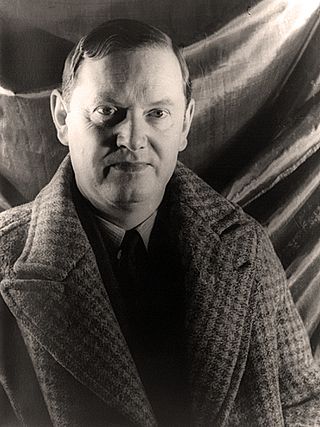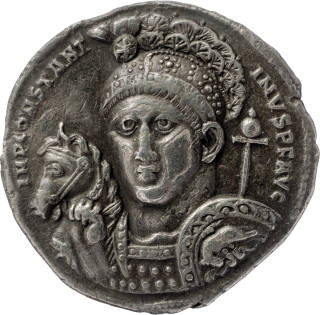
Arthur Evelyn St. John Waugh was an English writer of novels, biographies, and travel books; he was also a prolific journalist and book reviewer. His most famous works include the early satires Decline and Fall (1928) and A Handful of Dust (1934), the novel Brideshead Revisited (1945), and the Second World War trilogy Sword of Honour (1952–1961). He is recognised as one of the great prose stylists of the English language in the 20th century.

Constantine XI Dragases Palaiologos or DragašPalaeologus was the last Roman/Byzantine emperor, reigning from 1449 until his death in battle at the Fall of Constantinople in 1453. Constantine's death marked the definitive end of the Eastern Roman Empire, which traced its origin to Constantine the Great's foundation of Constantinople as the Roman Empire's new capital in 330.

Flavia Julia Helena, also known as Helena of Constantinople and in Christianity as Saint Helena, was an Augusta of the Roman Empire and mother of Emperor Constantine the Great. She was born in the lower classes traditionally in the city of Drepanon, Bithynia, in Asia Minor, which was renamed Helenopolis in her honor, although several locations have been proposed for her birthplace and origin.

Brideshead Revisited: The Sacred & Profane Memories of Captain Charles Ryder is a novel by the English writer Evelyn Waugh, first published in 1945. It follows, from the 1920s to the early 1940s, the life and romances of Charles Ryder, especially his friendship with the Flytes, a family of wealthy English Catholics who live in a palatial mansion, Brideshead Castle. Ryder has relationships with two of the Flytes: Lord Sebastian and Lady Julia. The novel explores themes including Catholicism and nostalgia for the age of English aristocracy. A well-received television adaptation of the novel was produced in an 11-part miniseries by Granada Television in 1981. In 2008, it was adapted as a film.

Flavius Julius Crispus was the eldest son of the Roman emperor Constantine I, as well as his junior colleague (caesar) from March 317 until his execution by his father in 326. The grandson of the augustus Constantius I, Crispus was the elder half-brother of the future augustus Constantine II and became co-caesar with him and with his cousin Licinius II at Serdica, part of the settlement ending the Cibalensean War between Constantine and his father's rival Licinius I. Crispus ruled from Augusta Treverorum (Trier) in Roman Gaul between 318 and 323 and defeated the navy of Licinius I at the Battle of the Hellespont in 324, which with the land Battle of Chrysopolis won by Constantine forced the resignation of Licinius and his son, leaving Constantine the sole augustus and the Constantinian dynasty in control of the entire empire. It is unclear what the legal status of the relationship Crispus's mother Minervina had with Constantine was; Crispus may have been an illegitimate son.

Constantine VII Porphyrogenitus was the fourth Byzantine emperor of the Macedonian dynasty, reigning from 6 June 913 to 9 November 959. He was the son of Emperor Leo VI and his fourth wife, Zoe Karbonopsina, and the nephew of his predecessor Alexander.

The True Cross is said to be the real cross on which Jesus of Nazareth was crucified, according to Christian tradition.
A number of alleged relics associated with Jesus have been displayed throughout the history of Christianity. While some individuals believe in the authenticity of Jesus relics, others doubt their validity. For instance, the sixteenth-century philosopher Erasmus wrote about the proliferation of relics, and the number of buildings that could be constructed from wooden relics claimed to be from the crucifixion cross of Jesus. Similarly, at least thirty Holy Nails were venerated as relics across Europe in the early 20th century. Part of the relics are included in the so-called Arma Christi, or the Instruments of the Passion.

A Handful of Dust is a novel by the British writer Evelyn Waugh. First published in 1934, it is often grouped with the author's early, satirical comic novels for which he became famous in the pre–World War II years. Some commentators regard it as a transitional work due to its serious undertones, pointing towards Waugh's Catholic postwar fiction.

Relics that are claimed to be the Holy Nails with which Jesus was crucified are objects of veneration among some Christians, particularly Roman Catholics and the Eastern Orthodox. In Christian symbolism and art, they figure among the Arma Christi or Instruments of the Passion, the objects associated with the Passion of Jesus. Like the other Instruments, the Holy Nails have become an object of veneration among many Christians and have been pictured in paintings.

The Helmet of Constantine was a form of helmet worn by the Roman Emperor Constantine the Great, now lost, which featured in his imperial iconography. According to a story recorded by Ambrose and others, it included relics gathered in the Holy Land by his mother, Empress Helena. Constantine's conversion to Christianity, which happened around AD 300, was of great importance. In this period it was believed that touching the body of the deceased or even something that came in contact with the person who had died was said to have special powers. This belief started a movement to find these relics to protect churches, cities, and even people.

The Feast of the Holy Cross, or Feast of the Cross, commemorates the cross used in the crucifixion of Jesus. In the Christian liturgical calendar, there are several different celebrations which honor and celebrate the cross used in the crucifixion. Unlike Good Friday, which is dedicated to the passion of Christ and the crucifixion, these feast days celebrate the Cross itself, as the sign of salvation. It is chiefly celebrated by Roman Catholics, Eastern Orthodox, Oriental Orthodox, Old Catholics, Lutherans and Anglicans, and to a lesser extent by Presbyterians, Methodists and Baptists. The most common day of commemoration is September 14th for Churches that use the Gregorian calendar and September 27th for Churches that use the Julian calendar, Ge'ez calendar, or Coptic calendar.

The Sword of Honour is a trilogy of novels by Evelyn Waugh which loosely parallel Waugh's experiences during the Second World War. Published by Chapman & Hall from 1952 to 1961, the novels are: Men at Arms (1952); Officers and Gentlemen (1955); and Unconditional Surrender (1961), marketed as The End of the Battle in the United States and Canada.

The Legend of the True Cross or The History of the True Cross is a sequence of frescoes painted by Piero della Francesca in the Basilica of San Francesco in Arezzo. It is his largest work, and generally considered one of his finest, and an early Renaissance masterpiece.

Stavrovouni Monastery is a Greek Orthodox monastery which stands on the top of a hill called Stavrovouni in Cyprus; it is sometimes simply known as Stavrovouni. The monastery is one of the few places where one can see a piece of the Holy Cross. Stavrovouni Monastery was founded by Saint Helena and Saint Constantine c. AD 327–329.
The Avalon Series is a series of fantasy novels written by Marion Zimmer Bradley and Diana L. Paxson. Paxson took over sole authorship after Bradley's death in 1999. The series focuses on the legendary island of Avalon and the various women who have shaped its history and that of Britain.

Flores de Mayo is a festival held in the Philippines in the month of May. It is one of the May devotions to the Blessed Virgin Mary and lasts for the entire month.

Judas Cyriacus ; Spanish: Quirico, Italian: Ciriaco), d. ca. AD 360, is the patron saint of Ancona, Italy. His feast day is celebrated in the Catholic Church on 4 May.
Elene is a poem in Old English, that is sometimes known as Saint Helena Finds the True Cross. It was translated from a Latin text and is the longest of Cynewulf's four signed poems. It is the last of six poems appearing in the Vercelli manuscript, which also contains The Fates of the Apostles, Andreas, Soul and Body I, the Homiletic Fragment I and Dream of the Rood. The poem is the first English account of the finding of the Holy Cross by Saint Helena, the mother of Emperor Constantine. The poem was written by Cynewulf some time between 750 and the tenth century. It is written in a West Saxon dialect, but certain Anglianisms and metrical evidence concerning false rhymes suggest it was written in an Anglian rather than Saxon dialect. It is 1,321 lines long.

The Chapel of Saint Helena is a 12th-century Armenian church in the lower level of the Church of the Holy Sepulchre in Jerusalem, constructed during the Kingdom of Jerusalem. The Armenians call it the Chapel of St. Gregory the Illuminator, after the saint who brought Christianity to the Armenians.

















